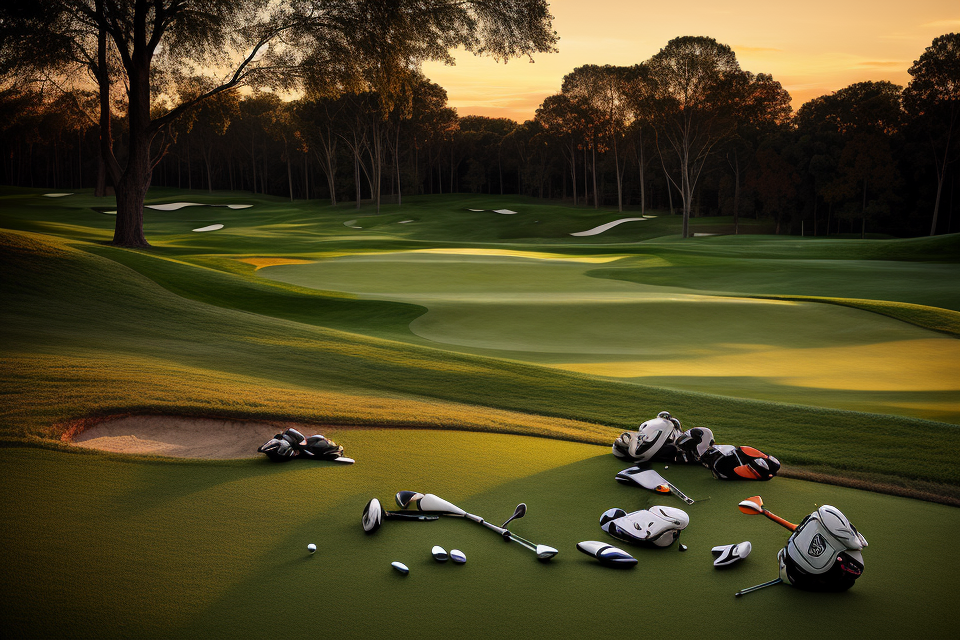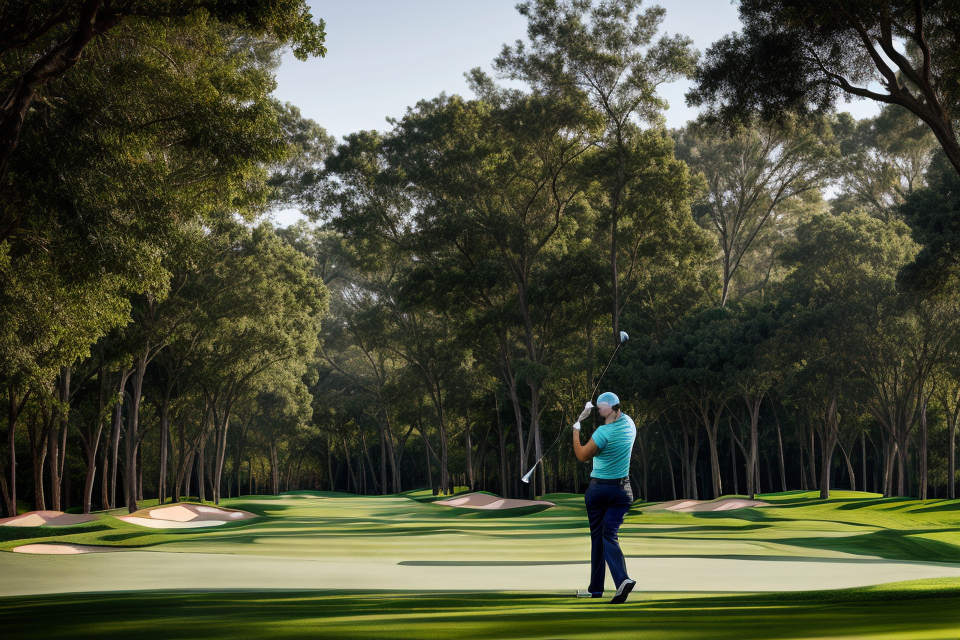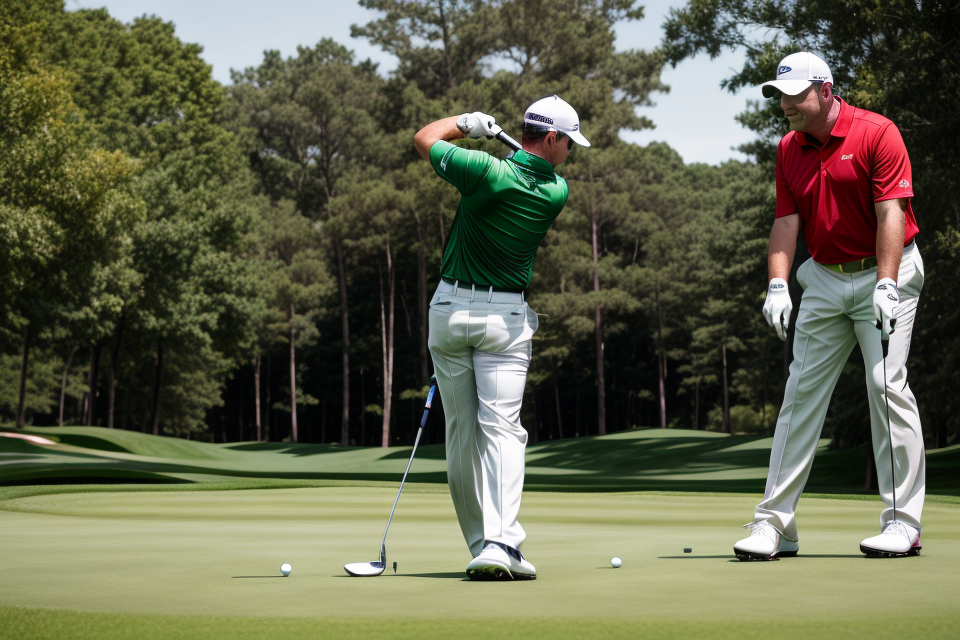
Golf is a sport that requires precision and skill, and the right equipment can make all the difference. But how do you know when it’s time to upgrade your golf clubs? In this guide, we’ll explore the key factors to consider when assessing the age and performance of your golf clubs. From the latest technology to the wear and tear on your clubs, we’ll help you determine whether it’s time to invest in new equipment. So whether you’re a seasoned pro or a beginner, read on to find out if it’s time to upgrade your golf clubs.
How to Determine the Age of Your Golf Clubs
The Importance of Age in Golf Clubs
The age of your golf clubs can have a significant impact on their performance. Here are some reasons why age matters:
Wear and Tear
Over time, golf clubs experience wear and tear, which can affect their performance. The clubhead may become dull, the shaft may become bent or cracked, and the grips may become worn or slippery. These issues can lead to decreased distance, accuracy, and control.
Technology Advancements
Golf club technology has come a long way in recent years, with new materials, designs, and manufacturing processes leading to improved performance. Newer clubs are often designed to be more forgiving, longer, and more accurate, and they may also offer better feel and control. As a result, older clubs may not be able to compete with the latest technology.
Player Improvement
As a golfer improves their skills, they may require more advanced equipment to help them reach their full potential. Newer clubs may be better suited to a higher level of play, offering more control and precision for more experienced players.
Overall, the age of your golf clubs is an important factor to consider when assessing their performance. If your clubs are old and showing signs of wear and tear, or if you feel that you are not able to perform at your best with them, it may be time to upgrade to newer equipment.
Signs of an Older Set of Golf Clubs
Obvious Signs
One of the most obvious signs of an older set of golf clubs is their physical appearance. Over time, golf clubs can become dull, discolored, and even rusted. The grips may also become worn and slippery, making it difficult to maintain a firm hold on the club during a swing. Additionally, older clubs may have loose or broken parts, such as club heads that no longer fit securely onto the shafts.
Hidden Signs
In addition to the obvious signs, there are also hidden signs that can indicate the age of your golf clubs. For example, the performance of your clubs may begin to decline over time, resulting in lower ball flight, reduced distance, and decreased accuracy. This is because the materials used to make golf clubs can become brittle and lose their elasticity, causing the clubhead to lose its impact and power.
Another hidden sign of an older set of golf clubs is the development of cracks or other types of damage to the clubhead or shaft. This type of damage can weaken the club and affect its performance, making it more difficult to hit the ball with precision and power.
Finally, if you have been using the same set of golf clubs for several years, it may be time to upgrade simply because of the advancements in technology. Newer golf clubs are designed with the latest materials and engineering techniques, which can help improve your game and make it easier to hit longer, straighter shots.
Methods of Determining the Age of Golf Clubs
Determining the age of your golf clubs is crucial in assessing whether it’s time for an upgrade. There are several methods you can use to determine the age of your golf clubs. Here are some of them:
Serial Number
One of the most straightforward ways to determine the age of your golf clubs is by checking the serial number. Golf club manufacturers typically engrave the serial number on the shaft or the clubhead. By comparing the serial number with the production date, you can determine the age of your golf clubs. However, it’s important to note that not all golf clubs have a serial number, and those that do may not have it in a visible location.
Condition
Another way to determine the age of your golf clubs is by assessing their condition. Golf clubs that are older than five years may start to show signs of wear and tear. For instance, the paint may start to chip, the grip may become slippery, or the shaft may start to bend. If you notice any of these signs, it may be time to upgrade your golf clubs.
Golf Club Groups
Finally, you can also determine the age of your golf clubs by grouping them together. Golf clubs that were purchased at the same time or from the same set are likely to be around the same age. By comparing the age of your golf clubs in this way, you can determine whether it’s time for an upgrade.
Assessing the Performance of Your Golf Clubs
Understanding the Factors Affecting Golf Club Performance
When assessing the performance of your golf clubs, it is important to understand the factors that can affect the way they perform. These factors can include:
Swing Style
Your swing style is one of the most important factors that can affect the performance of your golf clubs. Different swings require different types of golf clubs, and if your current clubs do not match your swing style, you may find that your shots are not as accurate or powerful as you would like them to be.
Swing Speed
Swing speed is another important factor that can affect the performance of your golf clubs. If your swing speed is slower than the recommended speed for your clubs, you may find that your shots do not have the distance or accuracy that you desire. On the other hand, if your swing speed is faster than recommended, you may find that your shots are too powerful and difficult to control.
Swing Consistency
Swing consistency is also a crucial factor that can affect the performance of your golf clubs. If your swings are inconsistent, your shots may also be inconsistent, leading to a higher likelihood of missed shots or poor accuracy. This is why it is important to choose golf clubs that match your swing style and abilities, so that you can maintain a consistent swing and achieve better results on the course.
Evaluating Your Golf Clubs for Optimal Performance
When assessing the performance of your golf clubs, it’s important to evaluate them for optimal performance. This means taking into account factors such as shot accuracy, ball flight, and distance and carry. Here are some things to consider:
Shot Accuracy
One of the key factors in evaluating the performance of your golf clubs is shot accuracy. If you find that you are consistently missing your target or hitting off-target, it may be time to upgrade your clubs. Factors that can affect shot accuracy include the quality of the clubhead, the shaft flexibility, and the grip size.
Ball Flight
Another important factor to consider is ball flight. If you notice that your ball flight is inconsistent or doesn’t match up with your intended shot, it may be time to upgrade your clubs. Factors that can affect ball flight include the loft of the club, the shape of the clubhead, and the aerodynamics of the club.
Distance and Carry
Finally, it’s important to evaluate your golf clubs for distance and carry. If you find that you are not getting the distance you need from your shots or are struggling to carry the ball over obstacles, it may be time to upgrade your clubs. Factors that can affect distance and carry include the length and flexibility of the shaft, the loft of the club, and the ball speed.
In conclusion, evaluating your golf clubs for optimal performance is an important part of determining whether it’s time to upgrade your equipment. By considering factors such as shot accuracy, ball flight, and distance and carry, you can make an informed decision about whether to invest in new clubs.
The Role of Technology in Upgrading Your Golf Clubs
Advances in Golf Club Technology
Materials
In recent years, there have been significant advancements in the materials used to construct golf clubs. Some of the most common materials used include:
- Metals: Golf club shafts are increasingly being made from materials such as titanium and graphite, which are lighter and stronger than traditional steel.
- Composites: These materials are made from a combination of different fibers, resins, and other materials. They offer a high strength-to-weight ratio and are used in the construction of many modern golf clubs.
- Ceramics: Ceramic materials are being used in some golf club components to increase durability and reduce weight.
Design
Golf club design has also evolved significantly in recent years. Modern clubs are designed to be more forgiving and easier to use for golfers of all skill levels. Some of the most notable design changes include:
- Moe shape: Modern golf club designs are more aerodynamic, which can help improve the clubhead speed and distance of shots.
- Adjustable loft: Many modern golf clubs feature adjustable loft options, which allow golfers to customize the angle of attack and shot trajectory.
- Deep cavity backs: These designs feature a more substantial, rounded rear section of the clubhead, which helps to increase the sweet spot and make the club more forgiving on off-center hits.
Construction
In addition to the materials and design changes, construction techniques have also evolved. Some of the most notable construction changes include:
- Milling: This is a process where the clubhead is milled from a solid block of material, which allows for greater precision and accuracy in the final product.
- Forging: Many modern golf clubs are forged, which involves shaping the clubhead using a heated metal rod. This process allows for a more consistent grain structure in the final product, which can improve the club’s performance.
- 3D printing: Some golf clubs are now being manufactured using 3D printing technology, which allows for highly complex and precise designs that would be difficult or impossible to produce using traditional manufacturing methods.
How Technology Upgrades Affect Your Game
Increased Distance
One of the most significant benefits of upgrading your golf clubs is the potential for increased distance. The latest technology in golf club design, such as stronger and lighter materials, can help you hit the ball further down the fairway.
Improved Accuracy
Upgrading your golf clubs can also lead to improved accuracy. Many modern golf clubs feature more precise designs and better weight distribution, which can help you keep the ball on target and avoid errant shots.
Enhanced Consistency
Another benefit of upgrading your golf clubs is enhanced consistency. The latest designs and materials can help you maintain a more consistent swing, leading to more consistent ball flight and better overall performance on the course.
Balancing Budget and Performance in Upgrading Your Golf Clubs
When it comes to upgrading your golf clubs, it’s important to balance your budget with your performance goals. Here are some tips to help you make the most of your investment:
Factoring in Your Budget
Before you start shopping for new golf clubs, it’s important to set a budget. Golf clubs can range in price from a few hundred dollars to several thousand dollars, depending on the brand, model, and features. Determine how much you’re willing to spend and stick to that budget.
Identifying Cost-Effective Upgrades
Not all upgrades are created equal. Some upgrades may offer significant performance improvements, while others may be more cosmetic in nature. Do your research and identify cost-effective upgrades that will have the biggest impact on your game.
For example, upgrading to a new driver with a larger sweet spot can improve your accuracy and distance off the tee, while upgrading to a new putter can improve your putting accuracy and consistency.
Investing in High-Quality Equipment
While it’s important to stay within your budget, it’s also important to invest in high-quality equipment that will last you for years to come. Golf clubs are an investment in your game, and cheap, low-quality clubs can be frustrating to use and may not last long.
Look for clubs that are made with high-quality materials and have a solid construction. Brands like Titleist, Callaway, and TaylorMade are known for their durability and performance.
In conclusion, upgrading your golf clubs can be a great way to improve your game, but it’s important to balance your budget with your performance goals. By factoring in your budget, identifying cost-effective upgrades, and investing in high-quality equipment, you can upgrade your clubs without breaking the bank.
Making the Decision to Upgrade Your Golf Clubs
Factors to Consider
Age and Condition of Your Current Clubs
One of the first factors to consider when deciding whether to upgrade your golf clubs is the age and condition of your current equipment. Golf clubs are designed to have a specific lifespan, and over time, their performance may begin to decline. Signs that your clubs may be due for an upgrade include:
- Rust or corrosion: If your clubs are showing signs of rust or corrosion, it may be time for an upgrade. This can affect the performance of your clubs and may even cause damage to the shafts or heads.
- Wear and tear: If your clubs have seen a lot of use and are showing signs of wear and tear, it may be time to replace them. This can include frayed grips, dented or scratched clubheads, or shafts that are bent or broken.
- Decreased performance: If you’ve noticed that your clubs are not performing as well as they used to, it may be time to upgrade. This can include lower ball flight, reduced distance, or a decrease in accuracy.
Your Skill Level and Goals
Another factor to consider when deciding whether to upgrade your golf clubs is your skill level and goals. If you are a beginner golfer, you may not need to upgrade your clubs as frequently as an advanced golfer. However, as you progress in your skills, you may find that your current clubs are not meeting your needs. Signs that your clubs may not be meeting your needs include:
- Inability to hit the ball with power: If you are struggling to hit the ball with power, it may be due to your equipment. Golf clubs that are not designed for your skill level may not provide enough power or distance for your swing.
- Consistent mis-hits: If you are consistently hitting the ball off-center or experiencing mis-hits, it may be due to your equipment. Clubs that are not designed for your swing may not provide the necessary control and accuracy.
- Inability to improve: If you have been practicing and taking lessons but are still unable to improve your game, it may be due to your equipment. Clubs that are not designed for your skill level may be holding you back from reaching your full potential.
Your Budget
Finally, your budget is an important factor to consider when deciding whether to upgrade your golf clubs. Golf clubs can be expensive, and it’s important to make sure that you are getting the most out of your investment. Signs that it may be time to upgrade your clubs include:
- Noticeable improvement in performance: If you have upgraded your clubs in the past and have noticed a significant improvement in your performance, it may be worth investing in new equipment.
- Wear and tear on your current clubs: If your current clubs are showing signs of wear and tear and are no longer performing as well as they used to, it may be time to upgrade.
- Comparing prices and features: If you are in the market for new golf clubs, it’s important to compare prices and features to make sure that you are getting the best value for your money.
Navigating the Upgrade Process
Researching and Comparing Options
Before embarking on the upgrade process, it is essential to conduct thorough research on the available options in the market. This can be done by visiting golfing websites, reading reviews, and consulting with fellow golfers. Comparing the features, performance, and prices of different clubs can help in making an informed decision.
Consulting with Golfing Experts
Consulting with golfing experts such as professional golfers, golf coaches, or club fitters can provide valuable insights into the latest trends and technologies in golf clubs. They can offer advice on the best clubs for your game, based on your swing type, playing style, and skill level. It is also helpful to seek the opinion of experts who have experience with your current clubs to determine if an upgrade is necessary.
Trialing New Clubs
Once you have narrowed down your options, it is important to trial the new clubs before making a purchase. Many golf retailers offer demo days or trial sessions where you can test the clubs on a golf course. This allows you to experience the feel and performance of the clubs firsthand and determine if they are the right fit for your game. It is also advisable to take professional advice and seek feedback from a golfing expert during the trial process.
In conclusion, navigating the upgrade process for golf clubs requires careful research, consultation with experts, and trial of new clubs. By following these steps, you can make an informed decision and choose the best golf clubs that suit your game and improve your performance on the golf course.
FAQs
1. How can I tell if my golf clubs are too old?
There are a few ways to determine if your golf clubs are too old. One way is to look at the condition of the clubs. If they are showing signs of wear and tear, such as rust or cracks, they may be too old to perform at their best. Another way to tell is to compare the technology of your clubs to the latest offerings from manufacturers. If your clubs are using outdated technology, they may not perform as well as newer clubs.
2. How long should I expect my golf clubs to last?
The lifespan of golf clubs can vary depending on how often they are used and how well they are maintained. With proper care and regular maintenance, golf clubs can last for many years. However, even the best-maintained clubs will eventually wear out and need to be replaced.
3. What are the benefits of upgrading to newer golf clubs?
Upgrading to newer golf clubs can improve your performance on the course. Newer clubs are designed with the latest technology and materials, which can help you hit the ball further and more accurately. Additionally, newer clubs are typically more durable and long-lasting than older clubs, so you may not need to replace them as often.
4. How can I determine if upgrading to newer clubs is worth the cost?
To determine if upgrading to newer clubs is worth the cost, you should consider your goals as a golfer and how your current clubs are performing. If you are consistently struggling to hit the ball the distance you want, or if your clubs are showing signs of wear and tear, it may be time to upgrade. Additionally, you should research the latest offerings from golf club manufacturers and compare them to your current clubs to determine if the new clubs will provide a significant improvement in performance.
5. What factors should I consider when choosing new golf clubs?
When choosing new golf clubs, there are several factors to consider. First, you should think about your swing and the type of golfer you are. Different clubs are designed for different types of swings, so it’s important to choose clubs that are a good fit for you. Additionally, you should consider the technology and materials used in the clubs, as well as the price and warranty. Finally, you should try out the clubs on the course to see how they perform before making a purchase.


